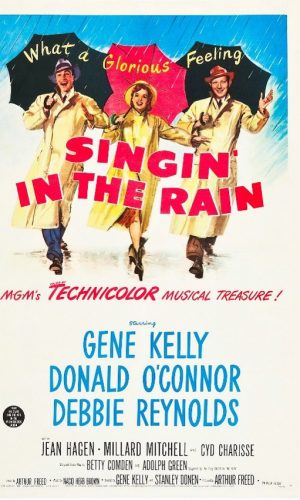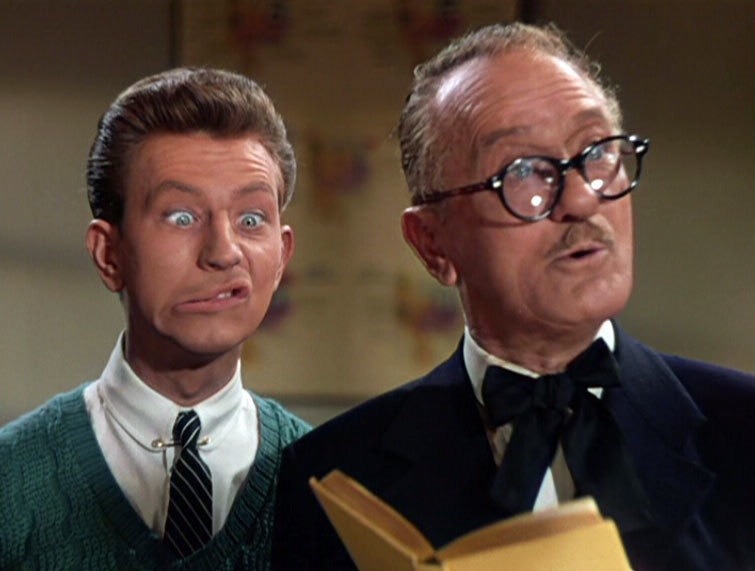
Editor’s note – announcement
Did you ever have the feeling that you need the world to stop for a bit just so you can think for a second? Just to slow things down to give you some time to understand what is going on.
“Wait A Minute, Wait A Minute. You Ain’t Heard Nothin’ Yet.”
– Al Jolson (The Jazz Singer)

Shh … Silence in the room. Turn off the lights. Let the show begin… The Jazz Singer is on the big screen tonight. And what a surprise! He is talking!
The Jazz Singer is considered to be the first talking movie in history. Although in reality, it is a little more complicated than that. Since the dawn of cinema, researches have been made to accompany movies with a synchronous sound. But for a while, it concerned only music and sound effect. The actor’s voice was never to be heard by the audience. The synchronized speech was added at the end of the twenties. Several “talkies” were produced and among them The Jazz Singer had a certain success when it was presented to the public in 1927 by Warner Bros. It contained songs and two minutes of dialogue using a new engine called the Vitaphone.
The popularization of talking movies happened between 1926 and 1934 and became a financial success from 1928 on. The revolution was slow and the studios had to adapt to the new constraints. At the beginning, the technical solution was to record the image and the sound separately to then play the two tracks at the same time. Innovations were fast to come through and step by step the whole process became easier. However, the recording of sound required specific installations inside the studios. The camera, which was very noisy at the time, had to be isolated in a box. And when scenes were shot outside, all the sounds from outdoors that could cover the voice of the actor had to be accepted. Thus, the earliest talkies were often entirely filmed inside the studios, which almost felt like going back in time after all the techniques developed for silent films. That’s why the propagation of talking movies took time and improvements to be fully established.
Why is it that suddenly speeches took the place of pantomime? Is language really necessary in movies? Lots of thinkers and actors proclaimed that talking withdrew the magic of uncertainty found in silent films. This magic was all about conveying emotions through a look or a gesture, and the beauty of it was that words were not necessary to understand this visual language. When comedians started to talk, it was not necessarily convincing. Adding a speech brought clarity but it didn’t do much except substitute the intertitles. Some people claimed that talking was threatening the universality cinema had acquired thanks to the pantomime. Charlie Chaplin was one of those individuals going against voice in film and continuing to produce silent movies. He strongly believed that talking would alter the vision of his vagabond character and he waited until 1936 to release his first talkie : Modern Times, a timid debut.
And the actors in this story? What about them? The iconic movie Singin’ in the rain, released in 1952, illustrates, with a lot of humour, the transition from silent to talking movies. A real declaration of love to the cinema in the twenties, it gathered a lot of references to specific actors or films. The plot takes place at the time when the success of The Jazz Singer started provoking a reaction in big companies. The star couple of Hollywood, Don Lockwood (Gene Kelly) and Lina Lamont (Jean Hagen), could not be more adulated by the public. They were everywhere! Lovers on screen, they actually hated each other in real life. But marketing is everything. However, the advent of talkies promised to be a major obstacle. The voice of Lina was… well, not adequate. Splitting up the successful couple was seen as impossible for the studio and the diction lessons were ineffective, which resulted in Lina’s career being compromised and with it Don’s as well. Yet, they needed to talk. So, Lina was given a voice double to preserve her public image.

And the actors in this story? What about them? The iconic movie Singin’ in the rain, released in 1952, illustrates, with a lot of humour, the transition from silent to talking movies. A real declaration of love to the cinema in the twenties, it gathered a lot of references to specific actors or films. The plot takes place at the time when the success of The Jazz Singer started provoking a reaction in big companies. The star couple of Hollywood, Don Lockwood (Gene Kelly) and Lina Lamont (Jean Hagen), could not be more adulated by the public. They were everywhere! Lovers on screen, they actually hated each other in real life. But marketing is everything. However, the advent of talkies promised to be a major obstacle. The voice of Lina was… well, not adequate. Splitting up the successful couple was seen as impossible for the studio and the diction lessons were ineffective, which resulted in Lina’s career being compromised and with it Don’s as well. Yet, they needed to talk. So, Lina was given a voice double to preserve her public image.


As a child, Singin’ in the Rain was, for me, a dreamlike vision of Hollywood. I had sparkles in my eyes and the only thing I wanted was to be born 50 or 70 years earlier in this fascinating world of stars. But jokes and romance aside, this film depicts a less joyful reality. When the success of talking movies became clear, the so-far undisputed leading figures of cinema found themselves at a turning point in their careers. Either they adapted and passed the test to use their voice in their acting, or they failed and slowly slipped into oblivion. Lots of them started participating in radio shows to let the public know their voice. They practiced their pronunciation with diction coaches (e.g. the memorable scene of ‘Moses supposes’ with Gene Kelly and Donald O’Connor) and recorded themselves at home to learn how and where to place their voices. Henceforth, an actor not only had to control his facial expressions but also to accord his voice to the character. This new, double requirement encouraged producers to cast stars from theatre. Therefore, someone like Al Jolson (The Jazz Singer), who had proved his talent on Broadway, was quick to obtain a new success on screen.
It’s only when studios had adapted their facilities, when the camera was able to move again out of its box and the sound taking was mastered, that the true interest in dialogues appeared and started to spread. Scriptwriters then adapted their writing to create more complicated stories, editors discovered new techniques of synchronization and actors renewed their way of playing. Eventually, the face of Hollywood, but also of international cinema was changed. Celebrities came and went in the process, as the forever-changing world of cinema can be cruel to the ones unable to adapt. It is nonetheless fascinating to see how the simple fact of modifying a mode of expression can turn over the course of a medium’s history. Can you believe that the destiny of some actors was decided on language proficiency? Well, this is maybe a little exaggerated but it certainly made a difference!
Many examples of the impact of the changes in cinema are expressed through movies themselves. The Artist, starring Jean Dujardin and Berenice Béjo, released in 2011, is one of those films that exposes what the transition to talkies could mean for certain personalities. The fall depicted in The Artist was surely high and dramatic. Although this does not necessarily correspond to reality, let’s face it: drama is a seller. In the end, silent or not, movies help us escape reality. And that’s exactly what we love about them.
As a child, Singin’ in the Rain was, for me, a dreamlike vision of Hollywood. I had sparkles in my eyes and the only thing I wanted was to be born 50 or 70 years earlier in this fascinating world of stars. But jokes and romance aside, this film depicts a less joyful reality. When the success of talking movies became clear, the so-far undisputed leading figures of cinema found themselves at a turning point in their careers. Either they adapted and passed the test to use their voice in their acting, or they failed and slowly slipped into oblivion. Lots of them started participating in radio shows to let the public know their voice. They practiced their pronunciation with diction coaches (e.g. the memorable scene of ‘Moses supposes’ with Gene Kelly and Donald O’Connor) and recorded themselves at home to learn how and where to place their voices. Henceforth, an actor not only had to control his facial expressions but also to accord his voice to the character. This new, double requirement encouraged producers to cast stars from theatre. Therefore, someone like Al Jolson (The Jazz Singer), who had proved his talent on Broadway, was quick to obtain a new success on screen.
It’s only when studios had adapted their facilities, when the camera was able to move again out of its box and the sound taking was mastered, that the true interest in dialogues appeared and started to spread. Scriptwriters then adapted their writing to create more complicated stories, editors discovered new techniques of synchronization and actors renewed their way of playing. Eventually, the face of Hollywood, but also of international cinema was changed. Celebrities came and went in the process, as the forever-changing world of cinema can be cruel to the ones unable to adapt. It is nonetheless fascinating to see how the simple fact of modifying a mode of expression can turn over the course of a medium’s history. Can you believe that the destiny of some actors was decided on language proficiency? Well, this is maybe a little exaggerated but it certainly made a difference!
Many examples of the impact of the changes in cinema are expressed through movies themselves. The Artist, starring Jean Dujardin and Berenice Béjo, released in 2011, is one of those films that exposes what the transition to talkies could mean for certain personalities. The fall depicted in The Artist was surely high and dramatic. Although this does not necessarily correspond to reality, let’s face it: drama is a seller. In the end, silent or not, movies help us escape reality. And that’s exactly what we love about them.

Did you ever have the feeling that you need the world to stop for a bit just so you can think for a second? Just to slow things down to give you some time to understand what is going on.

Fantasy is all around us. It is not just present in stories, books, movies, etc., where fantasy takes the form of a physical artefact, mostly designed to keep us entertained.

The realm of fantasy is a very wide one. In fact, its definition, when it comes to art, tends to depend on the artistic field. Pierre-George Castex defines it as “the brutal intrusion of mystery in real life”. This is the generic conception. Now if we try to narrow it down to the cinematographic field, a film of fantasy can just as well be one of science fiction as a horror movie. The point is to build the story on supernatural elements, from the world of magic and imagination. It doesn’t matter if the result is Alien or Harry Potter, it will still be a fantasy movie.